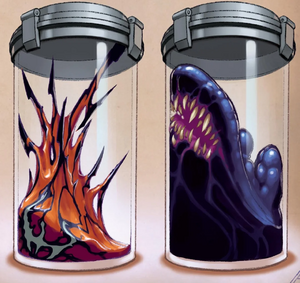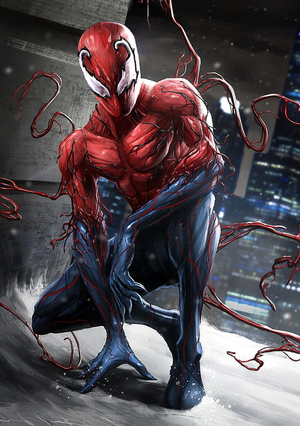Mutanoids

Mutanoids (Stellalimus Monstra) are an extraterrestrial species that unintentionally migrated to Earth.
Summary
Mutanoids are a sentient, extraterrestrial carbon based species resembling Slime Mold. Having originated from an unknown location, the Mutanoids were introduced to the Earth when an asteroid containing several members of the species fell into the Earth's atmosphere, breaking in half along the way and causing one half to fall to the far east and the other to western North America.
Description
In their natural form, all Mutanoids appear as an amorphous mass of slime-like substance. This substance can mold itself into seemingly any shape or form, and is capable of self locomotion, able to catch up to the average Human even in a full sprint. Alongside this, Mutanoids have the ability to change the color and texture of their form as well, giving them the ability to camouflage themselves from most conventional forms of detection. These abilities seem to stem from the Mutanoids' ability to rewrite their own DNA, allowing them to adapt to nearly anything.
Despite their appearance, Mutanoids are notably sentient and sapient, possessing an intelligence equivalent to Humans.
Reproduction
As a species of shape-changing slime-like organisms, Mutanoids are capable of both sexual and asexual reproduction. While their reproductive practices on their native world are unknown, the Mutanoids of Earth have shown the tendency to reproduce asexually initially. Then when a sufficiently sized colony is formed they pivot to sexual reproduction. Although like Human sexual orientation, this is subject to individual preference, with the observed behavior simply being the average.
Generational Differences
First, Second and Third Generations
Although all Mutanoids grow in strength with age, Mutanoids of the "first generations" are born with great advantages and are stronger on average than their higher generational peers. Their ability to control their own DNA is more precise, with their ability to adapt much quicker. In their natural form they tend to be much physically faster and stronger, despite there being no apparent physical difference between them and others. Most importantly of all, these Mutanoids are entirely self sufficient, and do not require a host organism for survival. This grants them a great deal of independence, as they are not dependent on their host's cooperation, consensual or not.
Fourth Generation and higher
The common Mutanoid, considered "lesser" by their lower generational peers. These Mutanoids are weaker on average, due to their species' strange capacity to produce offspring weaker than themselves. Because of this, these Mutanoids are born requiring a host organism to survive long term. Without one, a Mutanoid will die within a week's time, unless kept alive through artificial means.
Upon making physical contact with a desired host, the Mutanoid's body is merged with their host's organic tissue, essentially transforming them into an amalgamation of two creatures. With this connection made, the Mutanoid can now survive by continually feeding itself off it's host. Whether this relationship is long term symbiosis, or short term parasitism depends on the individual Mutanoid.
With time, a Mutanoid of these generations may eventually gain the strength themselves to no longer require a host. Although it's not uncommon for Mutanoids to remain with their host despite no longer needing them.

Diet
As mentioned earlier, a Mutanoid can attach itself to a host and feed off their body. However this isn't always possible. In cases where a Mutanoid is lacking a host (or simply of a lower generation), they may consume organic matter to satiate themselves. For fourth generation and higher Mutanoids, this tends to be less effective than utilizing a host, and only enables them to survive a few extra days without one.
Abilities
As mentioned earlier, the average Mutanoid is capable of altering their DNA, and automatically adapting to threats over time. They are also capable of altering the DNA of hosts, or other organisms they come into contact with if they wish. This grants them a great deal of freedom in what they can do, and a level of unpredictability as their ability to manipulate DNA is so great they can even grant themselves the abilities of Meta-Humans, if properly exposed first.
Most unusually, Mutanoids seem to be capable of long distance communication with each other. The means of this communication is unknown, however it seems that this method of communication is mainly used as a link to the Mutanoid Hive.
Weaknesses
Despite their powerful abilities, Mutanoids aren't invincible. Firstly, they require sustenance like any other organism. Second, they're physically vulnerable to anything that can destroy organic matter, such as highly acidic liquids or extreme heat and cold. Physical trauma through blunt force can also harm them, if it's of sufficient power. Although they tend to be more resistant to this than most other things.
Although Mutanoids can change and adapt, their ability to adapt takes time, and is significantly slower if a Mutanoid is of a higher generation. Their ability to alter their DNA is limited as well, with more complex alterations requiring exposure and/or time before a Mutanoid may take advantage of it. If something were to cause significant damage to a Mutanoid faster than it could adapt, it would die like any other organism.
Finally, the Mutanoids most unique weakness is perhaps their susceptibility to their own hosts. Although they can exert considerable control over their hosts if desired, their hosts are capable of the same amount of influence on them if they have sufficient willpower.
Behavior and Cognition
Being equivalent to Humans in intellectual and emotional capacity, each Mutanoid could be considered their own person, rather than a mere animal. And like Humans, individual Mutanoids exhibit their own personalities, preferences and beliefs, influencing how they interact with others.
The Mutanoid Hive
Similar to insects such as ants, Mutanoids exhibit a degree of Eusociality, typically within members of the higher generations. Although this hive is much more loosely organized than what you would find in the insect world, it is still a hive nonetheless.
Seemingly accessible from any location within an unknown range, most Mutanoids make use of this hive as an information network, rather than working together for it's benefit. This connection to the hive allows the spread of information, as well as a method of contact between individuals. Hosts may also access this hive, if allowed by their paired Mutanoid.